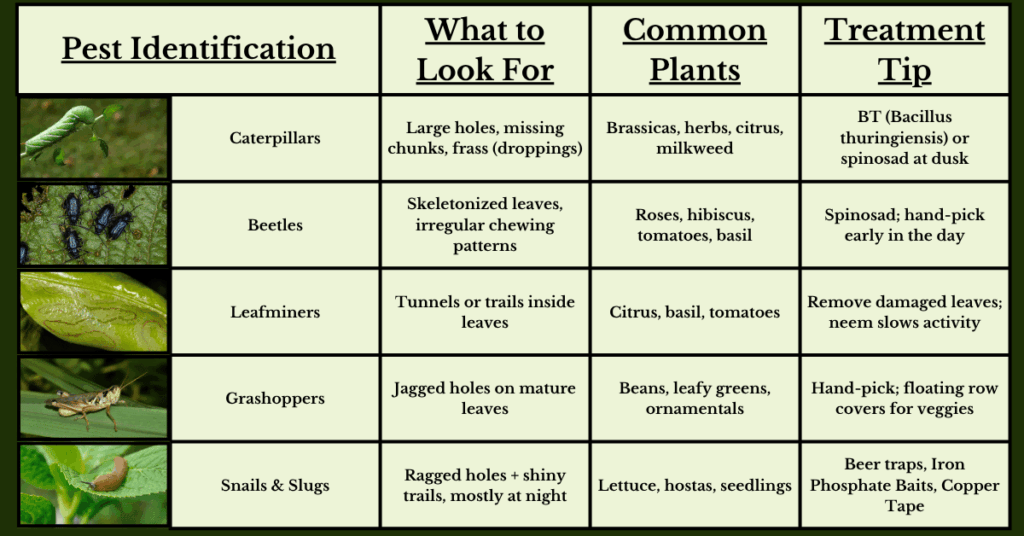Garden pests is fun and relaxing for many people. But pests can harm your plants. Knowing which pests are in your garden helps you protect your plants. This guide will help you identify common garden pests easily.

Credit: www.greenhousestores.co.uk
Why Identify Garden Pests?
Not all bugs in the garden are bad. Some bugs help plants by eating harmful insects. But some bugs eat plants and cause damage. Identifying the pest helps you choose the right action. You can save your plants and keep your garden healthy.

Credit: www.thecelticfarm.com
Signs of Pest Damage
How do you know if pests are in your garden? Look for these signs:
- Holes in leaves or petals
- Yellow or brown spots on leaves
- Sticky substances on plants
- Webbing on leaves or stems
- Wilting or stunted growth
- Chewed fruits or vegetables
If you see one or more signs, pests may be present.
Common Garden Pests
Here are some pests you might find in your garden. Each pest looks different and causes different damage.
Aphids
Aphids are small, soft bugs. They are green, black, or brown. Aphids suck the juice from plants. Leaves may curl or yellow. You may see sticky honeydew on leaves. Aphids often gather on new leaves or stems.
Spider Mites
Spider mites are tiny and hard to see. They make fine webs on plants. Leaves may look speckled or dusty. Spider mites suck plant juices. They cause leaves to dry and fall off.
Whiteflies
Whiteflies are small, white flying insects. They fly up when you touch plants. Whiteflies suck sap from leaves. Leaves become yellow and weak. Honeydew from whiteflies can cause mold growth.
Cutworms
Cutworms are fat, dark caterpillars. They hide in the soil by day. At night, they chew plant stems near soil. Young plants can fall over and die.
Slugs And Snails
Slugs and snails are soft and slimy. They eat holes in leaves and fruits. They leave shiny slime trails behind. These pests like damp, shady areas.
Japanese Beetles
Japanese beetles are shiny green and bronze. They eat leaves, flowers, and fruits. They leave behind skeletonized leaves. You can see many beetles together.
Caterpillars
Caterpillars are worm-like larvae of moths or butterflies. They chew on leaves and fruits. Some have bright colors or stripes. They can damage plants quickly if many are present.
Thrips
Thrips are tiny, thin insects. They are hard to see without a magnifier. Thrips cause silver or bronze marks on leaves. Leaves may curl or become distorted.
How to Check Your Garden for Pests
Follow these easy steps to find pests:
- Look under leaves for bugs or eggs.
- Check the stems and flowers carefully.
- Look for sticky substances or webs.
- Use a white paper to shake branches over it. Watch for falling insects.
- Check plants in the early morning or late afternoon.
Use This Table to Help Identify Pests
| Pest Name | Appearance | Damage Signs | Where Found |
|---|---|---|---|
| Aphids | Small, green, black or brown soft bugs | Curled or yellow leaves, sticky honeydew | On new leaves and stems |
| Spider Mites | Tiny, often red or yellow, with webs | Speckled leaves, webbing, dry leaves | Under leaves, on stems |
| Whiteflies | Small, white flying insects | Yellow leaves, sticky honeydew | Under leaves |
| Cutworms | Fat, dark caterpillars | Cut stems near soil, fallen young plants | Soil near plant base |
| Slugs and Snails | Soft, slimy, shell (snails) | Holes in leaves and fruits, slime trails | Shady, damp areas |
| Japanese Beetles | Shiny green and bronze beetles | Skeletonized leaves, chewed flowers | On leaves and flowers |
| Caterpillars | Worm-like, some colorful or striped | Chewed leaves and fruits | On leaves and stems |
| Thrips | Tiny, thin, sometimes black or yellow | Silver or bronze marks, curled leaves | On leaves and flowers |
Steps to Protect Your Garden
Once you identify pests, act fast. Here are some simple ways to protect plants:
- Remove pests by hand if you see few.
- Use water spray to wash off small insects.
- Plant herbs like basil or mint to repel bugs.
- Encourage helpful insects like ladybugs and bees.
- Keep the garden clean and remove dead leaves.
- Use natural pest sprays made from garlic or soap.
- Rotate crops to reduce pest build-up.
When to Ask for Help
Sometimes pests are hard to control. If damage grows fast, ask an expert. Local garden centers or extension offices can help. They can suggest safe treatment options.
Summary
Knowing garden pests helps you save plants. Look for holes, yellow leaves, webs, or sticky spots. Learn common pests like aphids, spider mites, and slugs. Check plants regularly. Use simple ways to stop pests. Keep your garden healthy and happy.
Gardening is easier when you understand pests. Take time to look closely at plants. Your garden will thank you with beautiful flowers and healthy fruits.
Frequently Asked Questions
What Are Common Signs Of Garden Pests?
Look for holes in leaves, yellowing, or sticky residue. These are telltale signs of pests.
How Do I Identify Garden Pests?
Observe the plant damage and look for tiny insects. Use a magnifying glass if needed.
Can Pests Harm My Garden Plants?
Yes, pests can damage leaves, stems, and roots. They may hinder plant growth.
What Attracts Pests To My Garden?
Overwatering, decaying plants, and unkempt gardens attract pests. Maintain your garden to deter them.
5 min read

